Coca Cola Marketing Plan in Vietnam
57 Pages10788 Words69 Views
Added on 2022-02-04
About This Document
This paper is a marketing plan recommended for Coca Cola Company. Firstly, we are going to analyze the Coca Cola Company (PESTLE, Marketing Mix and SWOT). Then, there are some key issues regarding Coca Cola Company concluded after the analysis. And finally, we have given solutions for Coca Cola to solve the issues.
Coca Cola Marketing Plan in Vietnam
Added on 2022-02-04
ShareRelated Documents
Page | 0
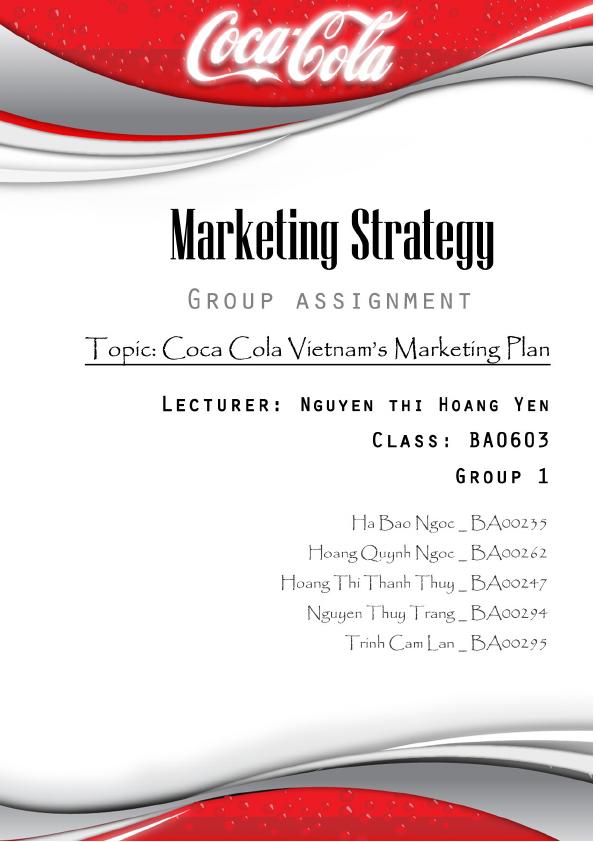
TABLE OF CONTENT
Page
I. Executive summary 2
II. Introduction 2
1. Background 2
2. Missions 3
3. Vision 3
4. Values 3
III. Marketing Environment Analysis 4
1. Macro Environment 4
2. Micro Environment: Porter’s Five Forces Model 13
3. Internal
IV. Marketing Analysis
1. Positioning
2. Marketing Mix
3. SWOT
4. SWOT Analysis
V. Key issues
VI. Marketing Plan
A. Objectives
B. Marketing Strategy
C. Action Plan
VII. Controls
VIII. References
Page | 1
Page
I. Executive summary 2
II. Introduction 2
1. Background 2
2. Missions 3
3. Vision 3
4. Values 3
III. Marketing Environment Analysis 4
1. Macro Environment 4
2. Micro Environment: Porter’s Five Forces Model 13
3. Internal
IV. Marketing Analysis
1. Positioning
2. Marketing Mix
3. SWOT
4. SWOT Analysis
V. Key issues
VI. Marketing Plan
A. Objectives
B. Marketing Strategy
C. Action Plan
VII. Controls
VIII. References
Page | 1
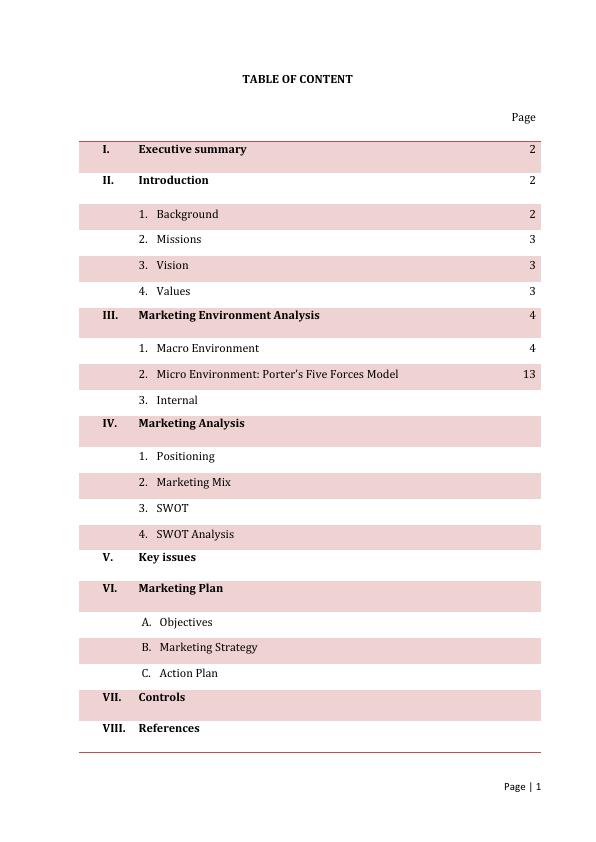
I. Executive Summary:
Coca Cola Company is the world’s leading soft drink maker, operates in more than
200 countries around the world and owns or licenses more than 500 brands of
nonalcoholic beverages.
This paper is a marketing plan recommended for Coca Cola Company. Firstly, we are
going to analyze the Coca Cola Company (PESTLE, Marketing Mix and SWOT). Then,
there are some key issues regarding Coca Cola Company concluded after the
analysis. And finally, we have gave solutions for Coca Cola to solve the issues.
II. Introduction:
1. Background:
Coca-Cola (also Coke) history began in 1886 when the curiosity of an Atlanta
pharmacist, Dr. John S. Pemberton, led him to create a distinctive tasting soft drink
that could be sold at soda fountains. He created a flavored syrup, took it to his
neighborhood pharmacy, where it was mixed with carbonated water and deemed
“excellent” by those who sampled it. Dr. Pemberton’s partner and bookkeeper, Frank
M. Robinson, is credited with naming the beverage “Coca-Cola” as well as designing
the trademarked, distinct script, still used today.
The first time appear of Coca Cola in Vietnam is in 1960. After that, Coca-cola
Indochina Pte Company was established officially in Vietnam on August 1995. Since
then, Coca-cola has some locations in Vietnam, which were united as one Beverage
Company called Coca-cola Vietnam with the head office located in Thu Duc District,
Ho Chi Minh City.
Page | 2
Coca Cola Company is the world’s leading soft drink maker, operates in more than
200 countries around the world and owns or licenses more than 500 brands of
nonalcoholic beverages.
This paper is a marketing plan recommended for Coca Cola Company. Firstly, we are
going to analyze the Coca Cola Company (PESTLE, Marketing Mix and SWOT). Then,
there are some key issues regarding Coca Cola Company concluded after the
analysis. And finally, we have gave solutions for Coca Cola to solve the issues.
II. Introduction:
1. Background:
Coca-Cola (also Coke) history began in 1886 when the curiosity of an Atlanta
pharmacist, Dr. John S. Pemberton, led him to create a distinctive tasting soft drink
that could be sold at soda fountains. He created a flavored syrup, took it to his
neighborhood pharmacy, where it was mixed with carbonated water and deemed
“excellent” by those who sampled it. Dr. Pemberton’s partner and bookkeeper, Frank
M. Robinson, is credited with naming the beverage “Coca-Cola” as well as designing
the trademarked, distinct script, still used today.
The first time appear of Coca Cola in Vietnam is in 1960. After that, Coca-cola
Indochina Pte Company was established officially in Vietnam on August 1995. Since
then, Coca-cola has some locations in Vietnam, which were united as one Beverage
Company called Coca-cola Vietnam with the head office located in Thu Duc District,
Ho Chi Minh City.
Page | 2
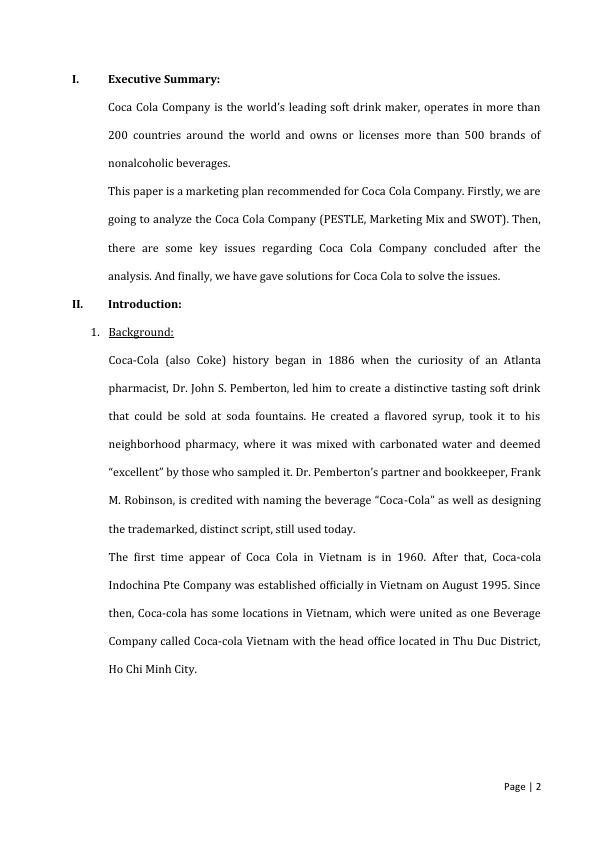
2. Missions:
Coca Cola identified their missions are:
o To refresh the world - in mind, body and spirit.
o To inspire moments of optimism - through our brands and actions.
o To create value and make a difference everywhere we engage.
3. Vision: To achieve above missions, Coca Cola Company has developed a set of goals,
which they will work with their bottlers to deliver:
o Profit: Maximising return to shareholders, while being mindful of our overall
responsibilities
o People: Being a great place to work, where people are inspired to be the best
they can be
o Portfolio: Bringing to the world a portfolio of beverage brands that
anticipate and satisfy people's desires and needs
o Partners: Nurturing a winning network of partners and building mutual
loyalty
o Planet: Being a responsible global citizen that makes a difference
o Productivity: Be a highly effective, lean and fast-moving organisation
4. Values: Coca Cola shared values that they are guided by are:
o Leadership
o Passion
Page | 3
Coca Cola identified their missions are:
o To refresh the world - in mind, body and spirit.
o To inspire moments of optimism - through our brands and actions.
o To create value and make a difference everywhere we engage.
3. Vision: To achieve above missions, Coca Cola Company has developed a set of goals,
which they will work with their bottlers to deliver:
o Profit: Maximising return to shareholders, while being mindful of our overall
responsibilities
o People: Being a great place to work, where people are inspired to be the best
they can be
o Portfolio: Bringing to the world a portfolio of beverage brands that
anticipate and satisfy people's desires and needs
o Partners: Nurturing a winning network of partners and building mutual
loyalty
o Planet: Being a responsible global citizen that makes a difference
o Productivity: Be a highly effective, lean and fast-moving organisation
4. Values: Coca Cola shared values that they are guided by are:
o Leadership
o Passion
Page | 3

o Integrity
o Accountability
o Collaboration
o Innovation
o Quality
III. Marketing environment analysis:
1. Macro environment:
a. Political:
Government has the power to set fines for the companies not meeting their standard
law requirements. The changes in laws and regulations, such as tax policy,
government regulations, social welfare policies, political risks might affect the
company as well as their entry in foreign countries. The political conditions, even
the civil conflict can impact to the markets and other governmental changes that
affect their ability to penetrate the developing and emerging markets that involves
the political and economic conditions. However, Coca Cola continuously monitoring
the policies and regulations set by the government.
Tax policy
Tax is the issue which any business operating in Vietnam is under the impact of laws
and regulations. However, the tax service has recently questioned for many large
foreign companies in Vietnam. Tax Agency has written requests for consideration
local inspection hole operations, profitability of the business to conclude if
companies report losses for the purpose of increasing costs to evade taxes or not.
Among them, Coca Cola Company reported losses in continuous operation for 20
years in Vietnam.
Page | 4
o Accountability
o Collaboration
o Innovation
o Quality
III. Marketing environment analysis:
1. Macro environment:
a. Political:
Government has the power to set fines for the companies not meeting their standard
law requirements. The changes in laws and regulations, such as tax policy,
government regulations, social welfare policies, political risks might affect the
company as well as their entry in foreign countries. The political conditions, even
the civil conflict can impact to the markets and other governmental changes that
affect their ability to penetrate the developing and emerging markets that involves
the political and economic conditions. However, Coca Cola continuously monitoring
the policies and regulations set by the government.
Tax policy
Tax is the issue which any business operating in Vietnam is under the impact of laws
and regulations. However, the tax service has recently questioned for many large
foreign companies in Vietnam. Tax Agency has written requests for consideration
local inspection hole operations, profitability of the business to conclude if
companies report losses for the purpose of increasing costs to evade taxes or not.
Among them, Coca Cola Company reported losses in continuous operation for 20
years in Vietnam.
Page | 4
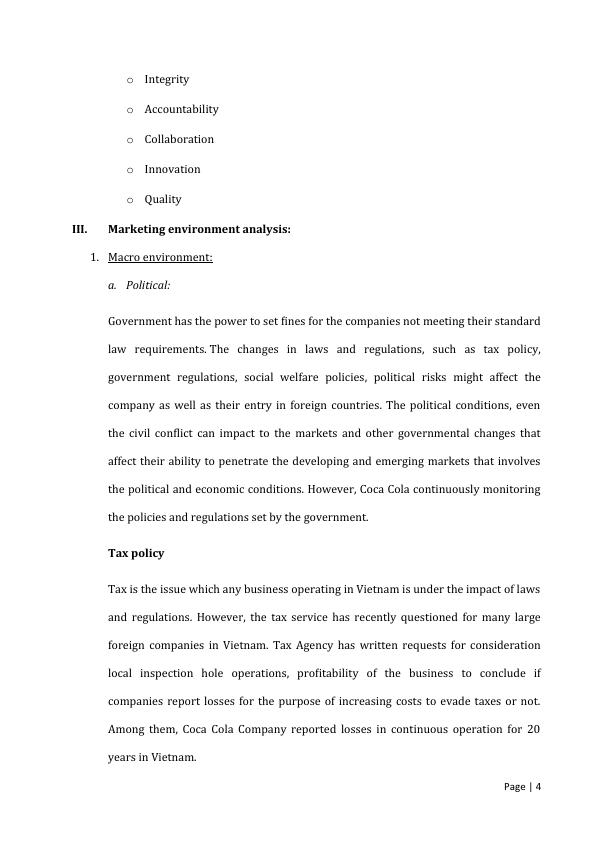
The biggest difficulty is prompted many experts to be the multinational corporations
often use the " guise " of proprietary material or technology , that agency is difficult
to determine the actual cost of inputs Vietnam businesses spend. Coca Cola,
according to the tax agency costs flavorings imported from the parent company
accounts for about 70-85 % of the cost of plant in Vietnam. The data cannot be
determined by the agency because of not knowing whether the proportion of flavor
additives from Coca Cola parent company in Vietnam is, compared to other markets
to put conclusions. However, this is the major reason Coca cola Vietnam proves for
their losses to dodge the government policy of tax. It also makes a bad reputation for
Coca cola in Vietnam.
Government regulations
As a famous brand, manufacturer, distributor and seller in beverage industry, the
Coca-Cola Company and other soft drink manufacturers are subject to antitrust laws
of general applicability. The Company may have an exclusive right to manufacture,
distribute and sell a soft drink product if its product is in substantial and effective
competition with others of the same general class in the market. It is the general
regulation in business in every country. However, there are some regulations strictly
limited and prevent the expanding. For example, the Coca cola has experienced
public policy which challenges them about the sale of soft drinks in elementary,
middle and high schools. At January 1, 2006, a number of states had regulations
restricting the sale of soft drinks and other foods in schools. Many of these restrictions
have existed for several years in connection with subsidized meal programs in schools.i
This regulation cares about the youth’s health as well as nutrition. This led to obesity
among students and it affected directly to the business of Coke Company in that
Page | 5
often use the " guise " of proprietary material or technology , that agency is difficult
to determine the actual cost of inputs Vietnam businesses spend. Coca Cola,
according to the tax agency costs flavorings imported from the parent company
accounts for about 70-85 % of the cost of plant in Vietnam. The data cannot be
determined by the agency because of not knowing whether the proportion of flavor
additives from Coca Cola parent company in Vietnam is, compared to other markets
to put conclusions. However, this is the major reason Coca cola Vietnam proves for
their losses to dodge the government policy of tax. It also makes a bad reputation for
Coca cola in Vietnam.
Government regulations
As a famous brand, manufacturer, distributor and seller in beverage industry, the
Coca-Cola Company and other soft drink manufacturers are subject to antitrust laws
of general applicability. The Company may have an exclusive right to manufacture,
distribute and sell a soft drink product if its product is in substantial and effective
competition with others of the same general class in the market. It is the general
regulation in business in every country. However, there are some regulations strictly
limited and prevent the expanding. For example, the Coca cola has experienced
public policy which challenges them about the sale of soft drinks in elementary,
middle and high schools. At January 1, 2006, a number of states had regulations
restricting the sale of soft drinks and other foods in schools. Many of these restrictions
have existed for several years in connection with subsidized meal programs in schools.i
This regulation cares about the youth’s health as well as nutrition. This led to obesity
among students and it affected directly to the business of Coke Company in that
Page | 5
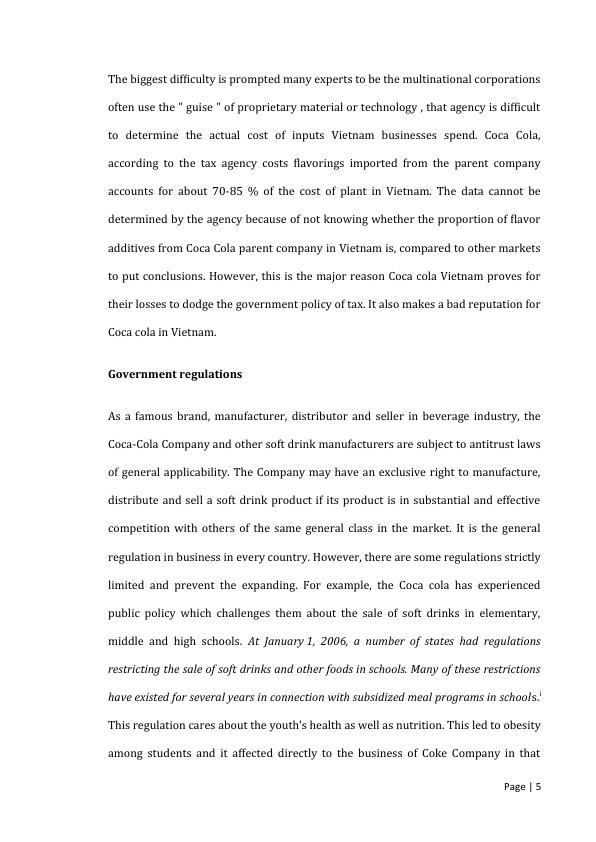
period. Moreover, the restrictive legislation, if it enacted for a long time widely, it
could impact on the Company’s products, image and reputation as well.
Social welfare policies
Coca cola offer high-quality brands and reputation in many countries on over the
world. Company significantly understand and believe that everyone should have
benefit. The business should bring benefit and refreshment to the people, which is
central to the way The Coca cola operate in communities around the world. The
company plays the role as a good neighbor and responsible citizen by helping
people. In Vietnam, the company set up many regional and local foundations,
organized charity programs in local. Some reality programs such as “Vietnam
pushcarts program” – helping economically disadvantaged women build sustainable
livelihoods; “Supporting education and youth development” scholarships to support
students in orienting and developing career in the future
Overall, Vietnam has a steady political condition. All above pose opportunities for
Coca cola Vietnam to develop the reputation with social programs. They do these
well to gain the people support. However, political situation or state regulation is
also the important point that Coca cola Vietnam must notice. It can prevent their
operation effectively in the future.
The opportunities for Coca Cola are Social welfare policies to improve their image.
The threats are Tax policy, government regulations to disclose negative information
and labels.
b. Economic:
Economics has a huge impact to the business of Coca Cola company.
Page | 6
could impact on the Company’s products, image and reputation as well.
Social welfare policies
Coca cola offer high-quality brands and reputation in many countries on over the
world. Company significantly understand and believe that everyone should have
benefit. The business should bring benefit and refreshment to the people, which is
central to the way The Coca cola operate in communities around the world. The
company plays the role as a good neighbor and responsible citizen by helping
people. In Vietnam, the company set up many regional and local foundations,
organized charity programs in local. Some reality programs such as “Vietnam
pushcarts program” – helping economically disadvantaged women build sustainable
livelihoods; “Supporting education and youth development” scholarships to support
students in orienting and developing career in the future
Overall, Vietnam has a steady political condition. All above pose opportunities for
Coca cola Vietnam to develop the reputation with social programs. They do these
well to gain the people support. However, political situation or state regulation is
also the important point that Coca cola Vietnam must notice. It can prevent their
operation effectively in the future.
The opportunities for Coca Cola are Social welfare policies to improve their image.
The threats are Tax policy, government regulations to disclose negative information
and labels.
b. Economic:
Economics has a huge impact to the business of Coca Cola company.
Page | 6
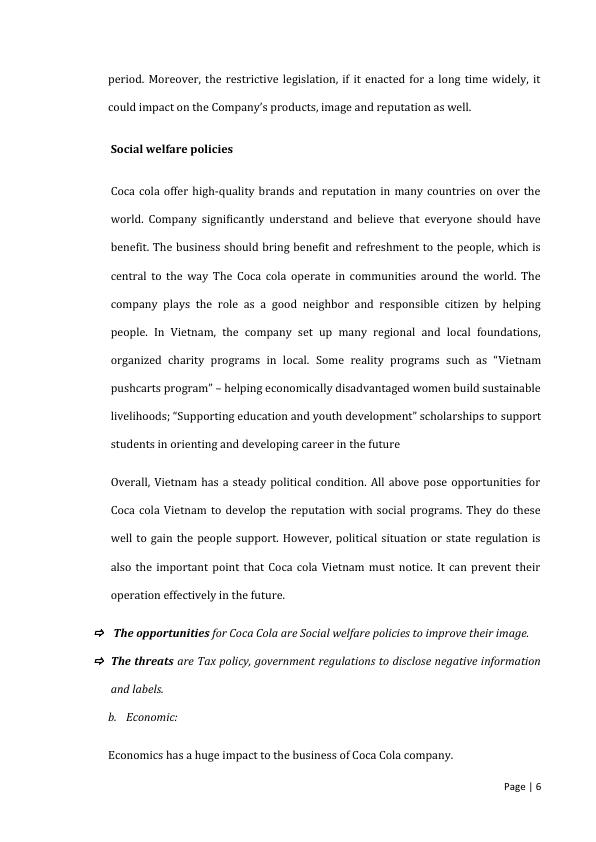
The economy in Vietnam is growing rapidly. It is advantages for the company's
operations. Announced $ 300 million investment in Vietnam in 3 years to 2015,
president of Coca-Cola, Muhtar Kent said that this was still an attractive market as
consumption of new people with 20% of the average world.
In Vietnam, the amount of Coca cola users is competitive with many other beverage
companies. Vietnam is a attractive market for domestic and foreign beverage
companies. Internal company operating in this industry such as Tan Hiep Phat is
very successful in touching consumers. The competitor, PepsiCo always plays
important role in sharing the marketing with Coca cola Vietnam. There are both
opportunities and challenges in consumption in Vietnam market.
The predicted GDP of Vietnam in 2014 will increase to ~ 6%. Growth of economy
will directly effect on the purchasing power of consumers. This growth will rise
prices of goods and encourage customer to spending tightly.
Moreover, the inflation also effect on the price of goods.
Page | 7
operations. Announced $ 300 million investment in Vietnam in 3 years to 2015,
president of Coca-Cola, Muhtar Kent said that this was still an attractive market as
consumption of new people with 20% of the average world.
In Vietnam, the amount of Coca cola users is competitive with many other beverage
companies. Vietnam is a attractive market for domestic and foreign beverage
companies. Internal company operating in this industry such as Tan Hiep Phat is
very successful in touching consumers. The competitor, PepsiCo always plays
important role in sharing the marketing with Coca cola Vietnam. There are both
opportunities and challenges in consumption in Vietnam market.
The predicted GDP of Vietnam in 2014 will increase to ~ 6%. Growth of economy
will directly effect on the purchasing power of consumers. This growth will rise
prices of goods and encourage customer to spending tightly.
Moreover, the inflation also effect on the price of goods.
Page | 7
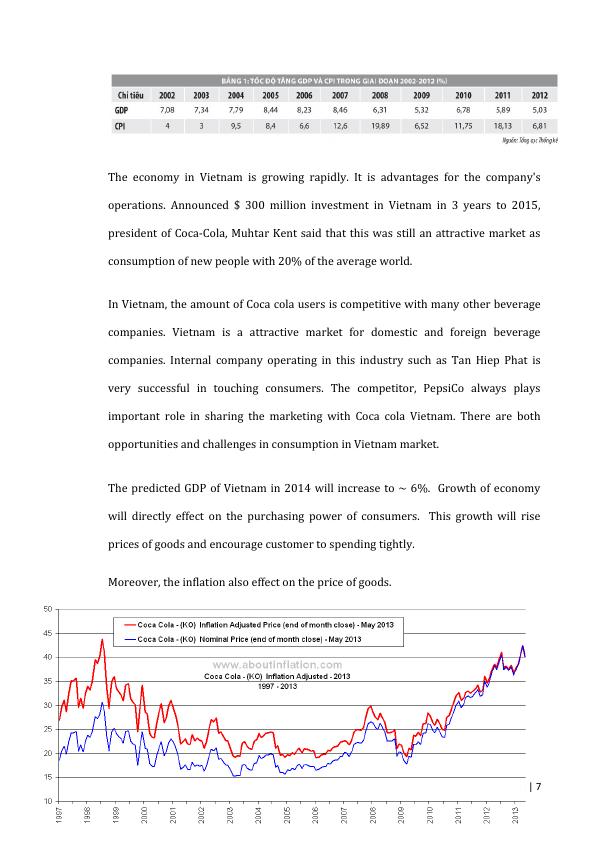
End of preview
Want to access all the pages? Upload your documents or become a member.
Related Documents
Coca-Cola Vietnam Case Studylg...
|36
|11019
|272
Analysis Of Coca-Cola’s Marketing Strategy And Campaignslg...
|4
|1963
|54
Business Analysis Assignmentlg...
|11
|2651
|295
The Diversification of Coca-Cola: Globalization & Strategic Fitlg...
|13
|4109
|525
Assignment on Principles of Logistics Managementlg...
|9
|3061
|371
The Coca Cola Company: Marketing Strategy.lg...
|16
|4509
|30
